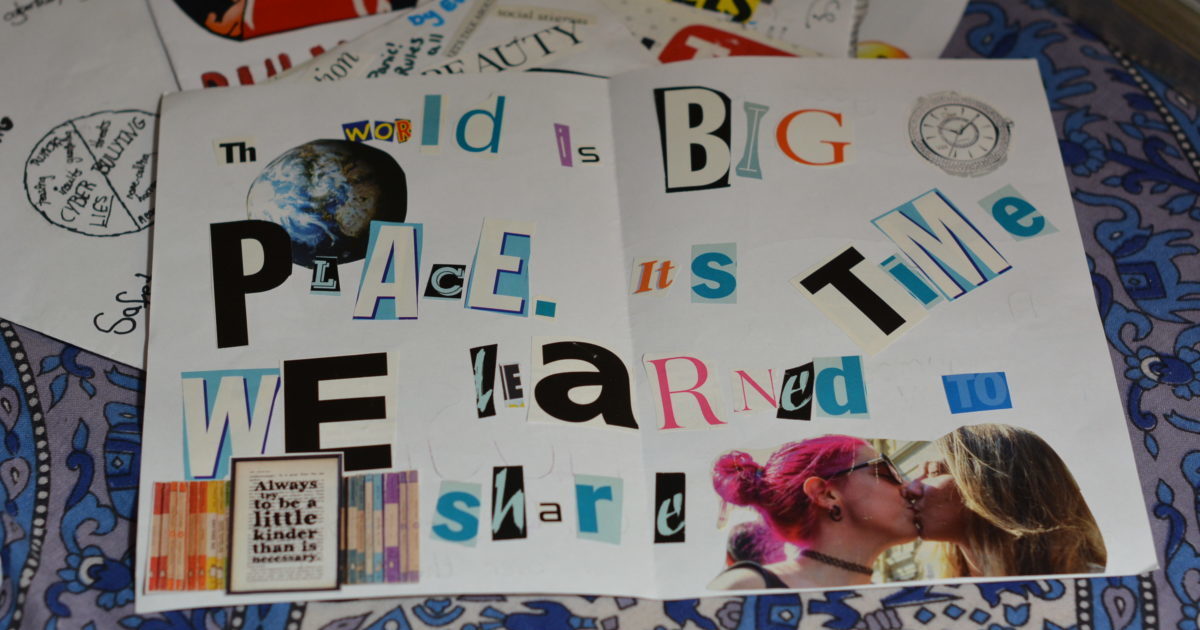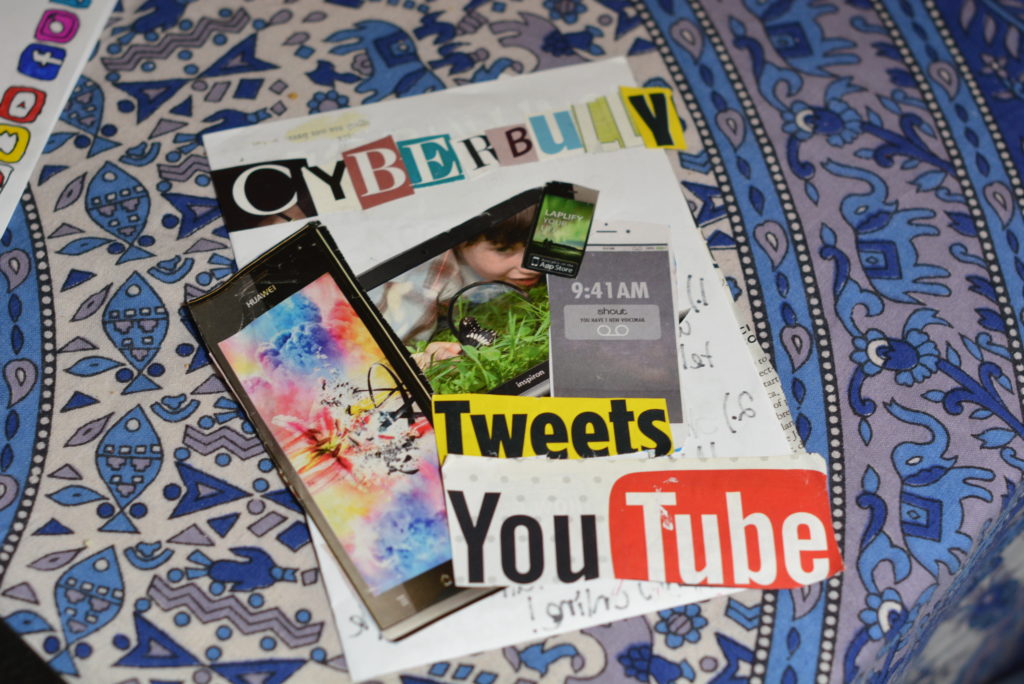Our Citizen Schools Writer-in-Residence Claire Askew takes you through the creative, often political act of zine making, which she's been using to get to know school pupils from across Edinburgh

I recently read a tweet by zine-maker @leiredriel, which said:
The zine is an artifact.
• art - artistic in that it is (hand-)made through a series of creative decisions
• i - medium of self-expression and individual agency
• fact - as document of resistance it addresses social truths prone to mainstream erasure in this era of fake news— K. (@leiredriel) January 27, 2019
“Zine” is short for “fanzine.” It's a type of tiny, do-it-yourself magazine or booklet, traditionally made using pictures and lettering cut from newspapers and regular magazines, a typewriter, and a photocopier. Fanzines were first popularised in the 1980s and 1990s, and they occupied the space now filled by blogs and social media. Zine-makers – usually teens and younger adults – wanted to create a space where they could talk about the things they cared about most. They wanted to be able to spread the word about cool things they were into – bands, TV shows, films, fashion – and express themselves creatively. Basically, before there was Instagram, there were zines.
Now, of course, we have Facebook, Twitter, Snapchat, Tumblr, Instagram and numerous other social media and blogging fora. It’s completely free – and very easy – to connect with like-minded people and talk about the things we care about. But zines haven’t gone away: instead, they’ve moved more in the direction of @leiredriel’s definition above. They’ve become more about creativity and self-expression, because you make them with your hands, not on a screen. They’re a way for the zine-maker to express their individuality: there’s literally #nofilter on a zine. And in a world where we’re no longer quite sure what information we can trust online, zines provide us with a tried and tested way to publish quickly, cheaply, and authentically, without gatekeepers.

When I needed to get to know them, I decided to ask the three Citizen schools groups – at Broughton, Craigroyston and Liberton High Schools – to make zines. I wanted to find out which issues and activities most interested the students; I wanted to give them a creative activity to do and ideally, one which related to books, reading, publishing (zine-making is still one of the fastest and cheapest forms of non-digital publishing). I’ve made zines in schools before, and so I know they can look very cool on a pinboard display: I wanted to give the groups something to show for their creative efforts. And I wanted to let them know about this easy and versatile form of DIY publishing, where all you need is your imagination, and a photocopier.
Of course, the students created some excellent work. Some opted to create traditional “fanzine” zines, about a favourite sport or activity (football and gaming were both popular). Others chose a thing that was important to them more personally: students in the ESOL group at Craigroyston High School made zines about where they were from and what they miss about their home countries, or about their mother tongue, language and words. In the Liberton group, there was a real focus on social justice issues, with zines being made on topics like feminism, gender, bullying, mental health, and sexuality. The students all took different creative approaches, too: some cut out a lot of images and went for a collage style (very typical of the zines of the 80s and 90s); others drew their own pictures, or filled their zines with hand-written text. The great joy of this activity is, there are no rules, and there’s no right or wrong way to do it. Just pick an issue, grab your paper, and go!



How to make a zine
for teachers and workshop leaders
You will need:
- white A4 paper, plain
- old magazines and newspapers for cutting up
- scissors
- glue sticks
- felt pens
- a photocopier
Step 1:
If you can find a few pre-made zines to show your zine-making group, that’s helpful. Edinburgh has its very own Zine Library (https://edinburghzinelibrary.wordpress.com/) who’d be able to help you with this… or there’s a fantastic book, Fanzines by Teal Triggs, which contains lots and lots of photos of fanzines throughout the ages (NB: this book may not be suitable for under 16s): https://www.waterstones.com/book/fanzines/teal-triggs/9780500288917
Step 2:
Once your group have got their heads around what a zine looks like, they need to pick the topic they’re going to zine about. It helps if it’s something they care about: a favourite activity, sport, band, etc; or a political issue they think more people should know about. With the Citizen school groups, I got each class involved in a discussion of possible topics and we recorded them on the whiteboard before we got started.
Step 3:
Everyone gets a single sheet of A4! Fold it in half, and this makes a zine of four ‘sides’, or pages. This is a small space, so each participant might want to spend a little time thinking about how they’ll arrange their information and visuals for maximum impact. The cover is important, too!

Step 4:
When it comes to making the zines, there are no rules! One student from my Craigroyston group filled the whole cover of her zine with a beautiful hand-drawn picture of her hometown. A boy in the Liberton group made his cover almost like a propaganda poster, with a cut-out figure pointing at the viewer and the words STOP BULLYING written in bubble lettering around the sides! The main thing to remember is, though cutting and sticking is fun, it’s important to put some words into your zine so people know what it’s about! Also, beware when working with old magazines the temptation to sit and read them… try to stay focused on looking for zine content!
Step 5:
As the zines come together, it’s important to make sure that any cut out or collaged material is well stuck down. You might also want to snip any sticky-out bits off the sides of your zines, if your stuck-on pictures or lettering have gone outside the confines of your paper. The zine needs to go through a photocopier, so it’s best to make sure that’ll happen smoothly!
Step 6:
Photocopy your zines either in colour or black and white (the old zines of the 80s and 90s were all black and white, and monochrome can look very cool!). Once you have copies, you can distribute them to friends, display them on a pinboard, leave them in strategic places for readers to come across them, post them… they’re yours to give to the world!

Claire Askew is a poet, novelist, and the Citizen Schools Writer-in-Residence. She’s the author of the poetry collection This changes things (Bloodaxe, 2016), and the novels All The Hidden Truths (Hodder, 2018) and What You Pay For (forthcoming, Hodder, 2019). Claire has worked as a teacher of Higher English and a Lecturer in Literature and Communication at Edinburgh College, as well as in community education settings across Scotland. She has a PDA in Adult Teaching and a PhD in Creative Writing, and you can find her online as @onenightstanzas.
Share this Post
